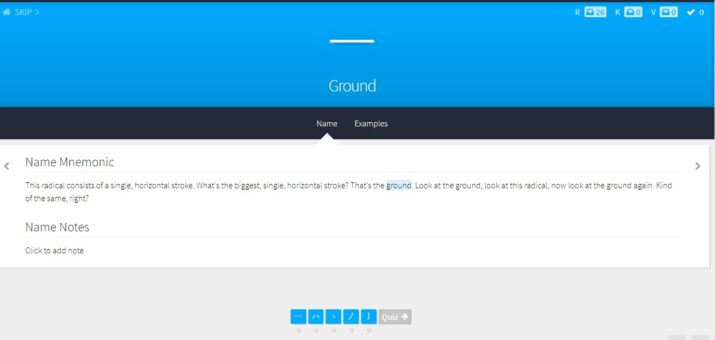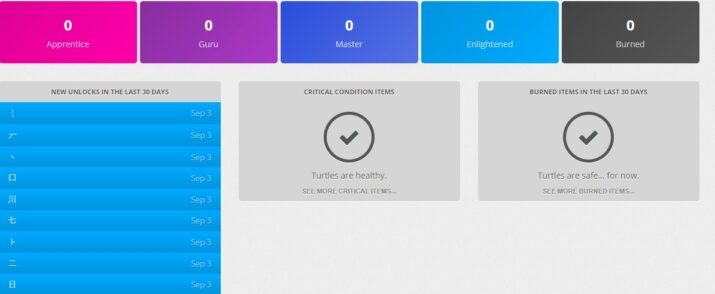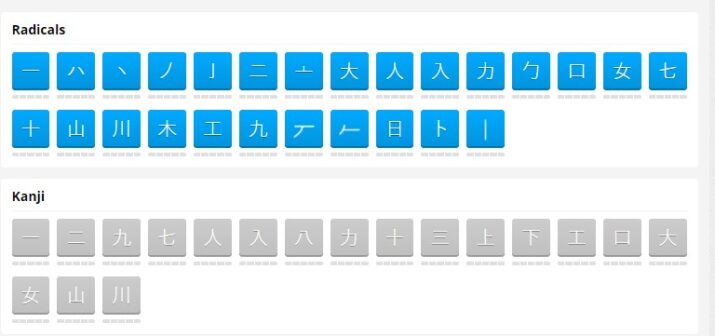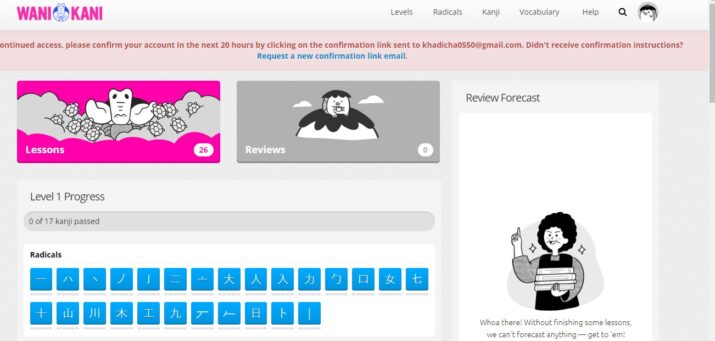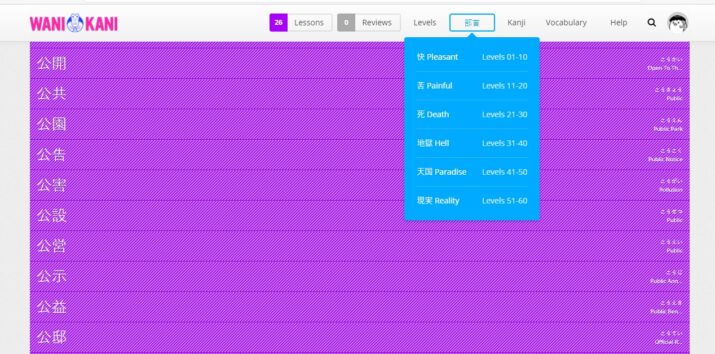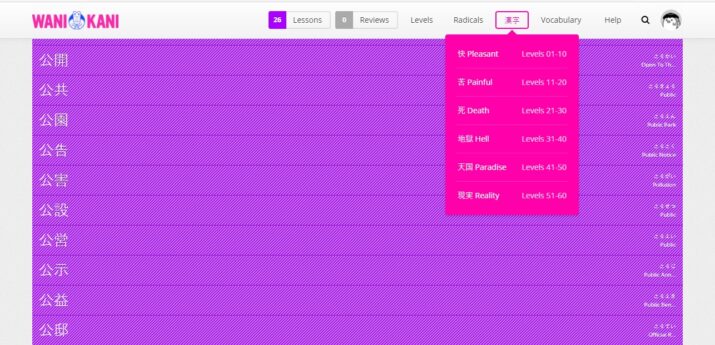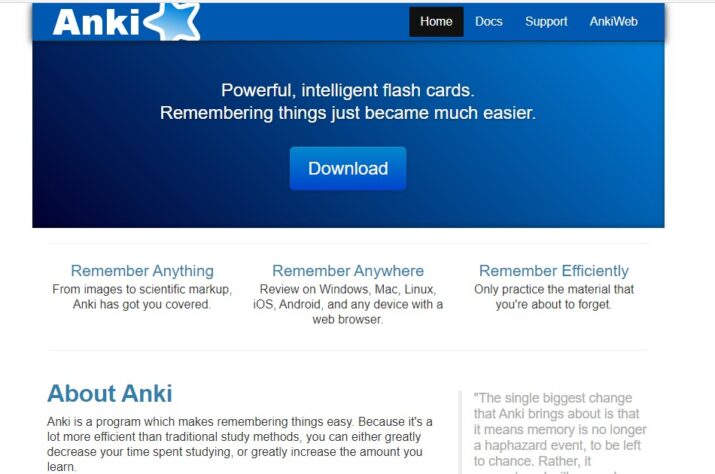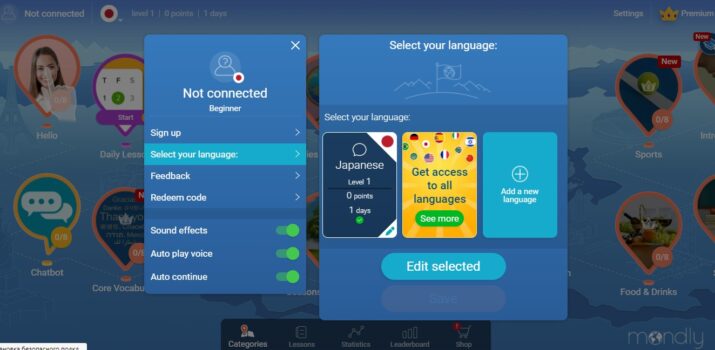Wanikani Review: Innovative But Not For All [2024 Edition]
By J Maver
January 10, 2024 • Fact checked by Dumb Little Man
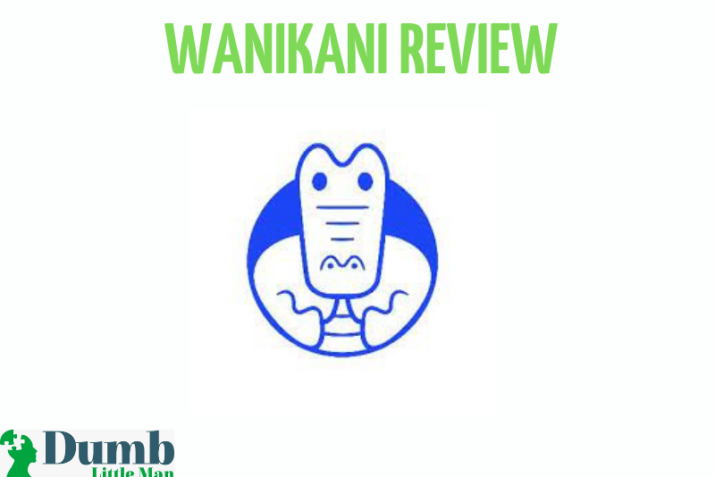
Wanikani is an innovative, useful site for beginners who want to learn Japanese kanji. It offers a comprehensive way for learning kanji through what appears to be a unique approach to mnemonics.The site provides mnemonic devices, a spaced repetition system (SRS) to teach radicals, kanji and vocabulary. Although it offers a great foundation in kanji, it doesn’t provide everything you will need to learn the language.
If you love Japanese culture or need to learn Japanese for any reason then you will need quality rsources to help you read kanji. Wanikani is one of the apps which is becoming popular vocabulary trainer for Japanese learners.
Is Wanikani the best way to learn Japanese kanji? Does Wanikani worth using and spending your time? Check our review of Wanikani. Decide for yourself whether to use it or not.
Wanikani Review
Wanikani is essentially a vocabulary and literacy trainer for Japanese kanji, paying enourmous attention to details. However, Wanikani isn’t designed for learning the language itself. It isn’t a Japanese course or an app to learn Japanese.
Wanikani will not teach you speaking or listening comprehension. It willn’t teach you grammatical knowledge but provides over 2000 kanji, radicals used in kanji and 6000 vocabulary words.
It teaches by using mnemonics for both kanji and and radical, learners are asked to form stories to help them remembering. Users practice these via a review-based system, where kanji or words you that you find correctly identify will appear less.
It has dated and overwhelming interface. Bland presentation of mnemonics, contrasted with the simplicity of other apps.
You can create a free account before laying any money down and use it for the first 3 levels at no risk.
Advantages
The app provides stories, mnemonic devices which are funny and make learning easy and memorable.
Critical condition items feature is another great facility: you can easily look at this resource to find out your your strong and weak points. You can restart a level if the new material is difficult for you.
Wanikani teaches you radicals. This is a huge reason to use the app. By introducing radicals early on, Wanikani creates a great foundation to work on.
Each kanji and vocabulary has an audio reading by a native speaker. These help you get used to the sound form of the word, alongside the written form.
Availability of external support in Wanikani community. This community made scripts taht can be used in PC version of the app.
CLICK HERE TO READ MORE ABOUT WANIKANI
Disadvantages
If you miss a day, you will have to deal with a bulk of lessons. Learners are allowed to have vocation mode only. But if you forget or you will need more time, you will surely have hundreds of lessons, huge set of patterns of a word to catch up.
Some of the mnemonics are hard to remember.
Membership fee. The first 3 levels of the app are free, progressing further requires subscription. A $9 subscription fee isn’t terribly expensive, but with completely free competitors such as Anki you had better choose the latter.
Wanikani is great for reading, but your aim is writing and speaking in Japanese,live or work in Japan this website doesn’t offer much. Example sentences are provided by the course but the acquisition of grammar is left to each induvidual.
Price
A monthly subscription costs $9, a yearly subscription is $89 and a lifetime subscription is $299. The first 3 lessons are free of charge.
An Overview of Wanikani
The app was created by Tofugu, a language learning company in 2012. The main aim of Wanikani is making kanji and vocabulary learning as easy and entertaining as possible.
For this purpose, The site supplies daily lessons for learning radicals, which are building blocks of kanji. The course provides lessons for the kanji themselves. Kanji is then used to create vocabulary items, new word patterns.
You can study at any time, not necessarily at the same time every day. The amount and newness of the content you receive every day will vary considering your learning. Because Wanikani determines, analyzes your learning and spaces them out based on SRS feature. ( Space Repetion System)
If you recently mislabeled one kanji several times in a row, for example, that kanji will appear sooner and more frequently than the one you labeled correctly.
CLICK HERE TO READ MORE ABOUT WANIKANI
60 levels of content to learn Japanese kanji.
Each level offers different amount of radicals, kanji, vocabulary considering the difficulty of topic. Moreover, each levels asks learners to compete previous lessons based test. The test will be played until you “burn” them and while you are learning new radicals.
It is crucial that new learned kanji has been “burned into your memory”. The site’s SRS determines that you know a radical, kanji so well that you got them burned and you don’t need to learn them further. Then, learned ones will never appear on your daily lessons.
Wanikani Labels
Wanikani has several labels to show your progress alongside with individual learning materials. These lables are:
- Apprentice label
- Guru label
- Master label
- Enlightened label
In order to go up in the levels, you need to raise your all previous kanji to at least Guru level. You are required to correctly name and define learned material several times in a row.
What exactly will you be taught in Wanikani? Why 2000 kanji and 6000 vocabulary words are chosen? Where does the idea come from?
The most part of the kanji taught consists of Joyo kanji which are common kanji that Japanese students in the middle school. To say exactly, The lexis is comprised of words created by those kanji.
Remembering the kanji isn’t an easy task. It usually takes a few years to learn kanji for a college student, however Wanikani claims that using its method you can learn kanji, vocab units, radicals, mnemonic system, stroke order in a year or two. Numerous users can’t back this claim because in fact it takes years to show near or complete fluence with readings in Japanese.
CLICK HERE TO READ MORE ABOUT WANIKANI
How To Use Wanikani?
You will need to sign up for using Wanikani app or website for its free version.
As we mentioned above, this version unlocks first 3 levels. You can revise each kanji given until it gets burned in your memory. When you hit level four, you will be prompted to sign up with a paid account.
The first days of your learning, you will only have a few radicals to learn , that’s why you will have some time to rest before actual learning starts. While the pace of lessons may seem very slow at first, it quickly changes as you raise your level.
You will only learn by heart names for radicals. You will need to learn both the spelling and definitions of kanji and vocab. Moreover, kanji requires learning both on’yomi and kun’yomi readings. They are originally the readings which comes from China and Japan respectively.
While Japanese students usually learn words based on meaning. They start with concepts that are easier to understand, Wanikani structures its lessons around the number and difficulty of the strokes.
It means that by introducing difficult notions earlier, they help you remember better difficult ones firstly and easier ones later. Learners can take notes and add a synonym to remember wanikani’s 2,000 kanji better.
The Structure Of The Lessons
A level consists of 2 lessons that you are obliged to review before moving to the next lesson. 140 items are provided for each level.. New ones will be available only when you have moved enough kanji and radicals to the “Guru” level. While completing any lesson you will be shown the characters, mnemonics, meanings, readings of kanji, pronunciation and sentences.You need to complete a set of 5 before you have to review the vocab items and get meaning and reading right for achieving the next set of 5. Completed patterns are stored in your revision part. The idea seems great? But does it really work?
The answer is sometimes “no”. A common complaint about the system is that some of the menmonics are so complex that users usually just ignore them. For this reason, many learners use ” Remembering the Kanji” which provides less-complicated mnemonics but doesn’t have an SRS.
What About Revisions?
When the item reaches its SRS (spaced repetition system) period, it automatically moves to your queue of revision. What you are asked to do in revision part is typing the meaning and reading of the pattern provided. Right answers moves the learned pattern to the higher bar, while incorrect one moves it lower. Supposing you get the item incorrect, you can review it, learn the meaning and it again moves randomly to your revision queue. Wanikani is fair in terms of SRS and the tool urges you to get accoustomed to timeline of learning. You should finish only your one day’s revisions.
The SRS of Wanikani is great if you keep up with it, but you should study less sometimes, if not you will be looking at a bulk of reviews. And this mountain can be difficult to dig your way out of all levels: apprentice guru master enlightened.
The worst thing about Waniakni’s SRS is its downfall, if you get behind, it can throw you off track and make your reviews amd tasks difficult. However, the good side of SRS is that it is challanging. Burning a difficult kanji is proof that you are improving.
CLICK HERE TO READ MORE ABOUT WANIKANI
How Long Does It Take To Complete Wanikani?
You can complete Wanikani’s one lesson for a week’s time if you practice at the same pace. This a quite difficult task, so many users recommend to spend around 11 days per level. You will spend around 660 days to complete all lessons. And plus time spend for burning every item. However, if you work hard, you can complete around a year and a half.
What Level Of Japanese Do I Need To Use Wanikani?
If you want to learn Japanese by using Wanikani, you must understand the basics of hiragana and katakana. They are both considered as the foundation of most mnemonics. If you have the ability to read hiragana quickly, you won’t have any problems with completing reviews, the lesson will flow easily for you.
Wanikani’s Mnemonics: Good Or Bad?
The mnemonics in the program are of two types: great and average. Most of them are abscure, some are weird, some are meaningless. Those factors can make them memorable or hard to learn by heart. Many of mnemonics also include characters which occur in fron of you constantly. For instance site founder’s name is Koichi,that’s why a lot of mnemonics have the name Koichi.
A mnemonic that is really crazy, sticks well. There are some people preferring only this type of mnemonics. If it’s you, then it isn’t the right site for your learning Japanese and learning kanji also.
Is Wanikani Worth Money?
Wanikani is good example of an app designed for learning Japanese kanji, characters and vocabulary words. But wait! Is the price reasonable to spend while learners have a huge choice among several free ones?
The tool is quite expensive as it has cleanly designed package and provides an exact road map for completing a large number of knaji.
Wanikani isn’t a stand alone all-in-one Japanese course. You can achieve great language success using Wanikani’s kanji section, but the program doesn’t offer courses for grammar, vocabulary, speaking, writing practices, JLPT exam.
Alternatives To Wanikani.
If you are aimed at learning Japanese seriously, you should look for other apps. You can spend your time to read numerous posts about Japanese learning courses. But wait! We offer you to read our quick review of alternative apps to Wanikani for learning the language.
Genki
Genki is a 2-volume Japanese textbook published by The Japan Times years ago, to be exactly, in 1999. It was revised and updated in 2011. It has gained quite following and remains popular choice even for those in self-learning community.
Genki is for:
Absolute beginners and classroom students.
Really motivated people.
Beginners who have just started learning but has language anxiety.
People who wnat to get JLPT lecel 5 or 4.
Genki isn’t for:
Tourists
Unmotivated and lazy students.
People who want to learn kanji, vocab items, words, word stroke only.
CLICK HERE TO READ MORE ABOUT GENKI
Anki
Anki is a good example of the app designed for improving memory and recall. It is best option for studying vocabulary, word stock. The application provides a huge amount of vocab learning resources and materials.
Anki has flashcards for different categories:
For vocabulary and word reviews
For hiragana and katakana mastering
For kanji mastering
For mastering verb conjugations
For featuring not only a word, but whole phrases and sentences
Pimsleur
Pimsleur is a perfect app for beginning students. Many posts on net focuses on its recall method. Pimsleur courses are known as best audio courses to speak. Their method includes a question, recall, response technique which is very effective for helping you acquire basics of a language.
Advantages:
Each Lesson is designed to teach you actual listening and speaking.
Functionaly vocabulary and words are presented.
Easy to use compared with Wanikani.
You have the option to switch between languages.
Disadvantages:
Teaches more formal language
Most people review that the app teaches limited vocabulary.
CLICK HERE TO READ MORE ABOUT PIMSLEUR
Mondly
Mondly is also a good example of language teaching apps. It claims that it will teach you ” play your own way to a new language” and get you speaking “faster than anyone else”. It has been designed by combining principles of neuroscience with cutting edge technologies.
Mondly offers a variety of options:
Mondly
MondlyWORKS
Mondly VR
MondlyAr
MondlyKIDS
Oxford Assessments
CLICK HERE TO READ MORE ABOUT MONDLY
Conclusion
To sump up, Wanikani is an entertaining way to learn essential kanji and vocabulary patterns. Wanikani provides good SRS and mnemonics, but we can see that when they work they have certainly downfalls.
Wanikani provides a strong doundation for reading, however, it won’t teach you everything about the language. There are other apps, courses that teach the language in a more detailed way.
If you are a beginner, the site will provide all the essential kanji and vocabulary you need. If you are going further along in your studies, the site is not useful for you. It may take a lot of time to learn.
If you are going to learn how to speak, Wanikani is just a stepping off point. If you are going to write the program can’t offer you much.
We can deduce that Wanikani is a good application for both retention and lear ning of kanji. However if you are willing to learn further and have willing to spend money on it, I would recomment you to use other alternative ones to Wanikani. Such as Pimsleur, Mondly, Anki, Genki,Babbel. They offer a variety of good content to boost your level.
CLICK HERE TO GET PIMSLEUR AT A DISCOUNTED PRICE!
CLICK HERE TO GET MONDLY AT A DISCOUNTED PRICE!
J Maver
Passionate in tech, software and gadgets. I enjoy reviewing and comparing products & services, uncovering new trends and digging up little known products that deserve an audience.

